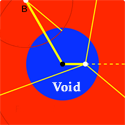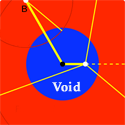No privilege for earthly observers
According to most cosmologists, there is nothing special about us as observers of the universe. Still, some theories shirk this so-called Copernican principle, suggesting that the universe is not homogenous. Rather, these theories explain the observed accelerated expansion of the universe without invoking dark energy, and instead assume we are near the center of a void, beyond which denser matter pulls outwards.
In a paper appearing in Physical Review Letters, Pengjie Zhang at the Shanghai Astronomical Observatory and Albert Stebbins at Fermilab show that a popular void model, and many others aiming to replace dark energy, don’t stand up against telescope observation.
Galaxy surveys show the universe is homogeneous, at least on length scales up to a gigaparsec. Zhang and Stebbins argue that if larger scale inhomogeneities exist, they should be detectable as a temperature shift in the cosmic microwave background—relic photons from about years after the big bang—that occurs because of electron-photon (inverse Compton) scattering. Focusing on the “Hubble bubble” void model, they show that in such a scenario, some regions of the universe would expand faster than others, causing this temperature shift to be greater than what is expected. But telescopes that study the microwave background, such as the Atacama telescope in Chile or the South Pole telescope, don’t see such a large shift.
Though they can’t rule out more subtle violations of the Copernican principle, Zhang and Stebbins’ test sets a high bar for future models to pass. – Jessica Thomas





